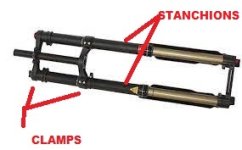TS81
1 mW
- Joined
- Jul 27, 2021
- Messages
- 17
Hi,
my Sur-Ron creaks when breaking strongly with the front brake. The creaking noise comes NOT from the brake. It comes somewhere from the handlebar bearing or next to it. I already checked the stem bearings but found nothing wrong (see pictures in video). Also set the bearing clearance but not change. Have the Sur-Ron about 6 month and have 2000 KM. There are no visible cracks in the frame or any clearance. I don't known where the sound comes from. It's also noticable riding in heavy terrain. It works fine but the sound is annoying and also a little bit frightening.
Any ideas?
[youtube]wxikuycsuac[/youtube]
regards
Timo
my Sur-Ron creaks when breaking strongly with the front brake. The creaking noise comes NOT from the brake. It comes somewhere from the handlebar bearing or next to it. I already checked the stem bearings but found nothing wrong (see pictures in video). Also set the bearing clearance but not change. Have the Sur-Ron about 6 month and have 2000 KM. There are no visible cracks in the frame or any clearance. I don't known where the sound comes from. It's also noticable riding in heavy terrain. It works fine but the sound is annoying and also a little bit frightening.
Any ideas?
[youtube]wxikuycsuac[/youtube]
regards
Timo



